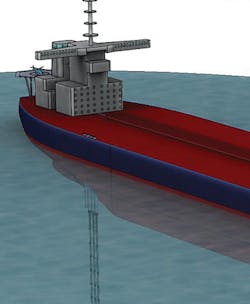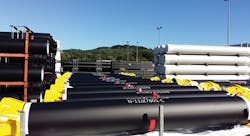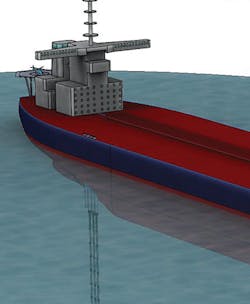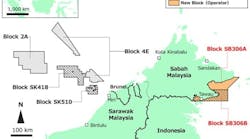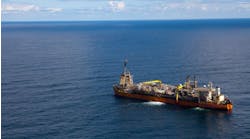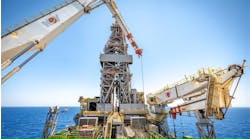Pierre Guérin
Bardot Group
FPSOs and floating liquefied natural gas (FLNG) units incorporate various and complex systems for oil and gas processing and liquefaction operations. Water intake risers (WIRs) are designed to supply the necessary volume and flow of cold water to cool down the topsides process.
Traditionally, WIRs have been made from steel, which introduced numerous constraints such as weight, diameter limitations and stiffness of the line. In addition, the technology would limit the pumping depth to 150 m (492 ft), where the water temperature does not go below 15°C (59°F).
However, there are growing requirements in the offshore sector to increase the efficiency of the topside process, the power generation, and to reduce the overall footprint of the processing facility. To do this, WIRs must reach colder water at a temperature of 5-7°C (41-45°F), which requires pumping at a depth of 600-1,000 m (1,968-3,281 ft). Bardot has designed a WIR with a sufficiently low weight to be able to pump water as deep as 1,000 m, while withstanding the potential mechanical stresses built up over 30 years by a combination of vessel motion, currents, vibration, and the WIR structure’s own mass. The materials employed (the High Density Polyethylene for the pipes has been qualified for use offshore by most major oil companies) have been selected for their good behavior over time. In addition, the design conservatively considers end-of-life properties, and guarantees that no maintenance will be necessary, aside from routine inspections.
Main features of the deepwater WIR are:
- HDPE pipes
- New type of flexible connection
- Riser seats
- Strainer and ballast
- Polymeric tapers.
The top connector ensures the link between the floating unit and the riser. Its purpose is to withstand the static and dynamic loads, limit the load transfer between the vessel and riser, and to ensure continuous inner flow. The HDPE line is composed of segments flanged or welded together to achieve the desired length. Segment length will depend on the FPSO/FLNG’s installation constraints, and can vary from a few meters (typically 12 m, or 39.4 ft) to more than 100 m (328 ft). HDPE material is non-corrosive, inert, sustains high and low temperatures, is resistant to marine growth, of low density (around 0.9) and can be easily welded. Finally, a strainer, made of HDPE or steel, is attached to the end of the line to prevent unwanted particles or other matter from being sucked in the flow.
Bardot Group has engineered the WIR to fulfil critical design criteria such as a maximum acceptable top tension, maximum acceptable compression, maximum bottom excursion, maximum pressure loss, acceptable minimum bending radius, stress use factors, and service life requirement, with special attention paid to the HDPE mechanical characteristics.
WIRs are designed to fit requirements of water depth, temperature, flow rate, and to accommodate the hydrodynamic stresses of the operational environment. The company performs different analyses during the engineering process. The dynamic analysis includes global behavior, structural and hydrodynamic assessments and focuses on dynamic performance under extreme conditions; fatigue damage caused by waves and vessel motions; vortex-induced vibrations; interference with other risers; and installation analysis.
An extreme analysis is performed to check the suitability of the proposed WIR configuration, assess the WIR’s dynamic response to environmental loadings (wave and currents), and to determine the WIR interface loads. Fatigue analysis will assess the in-place fatigue damage along the WIR sections under operational wave loads (for HDPE and steel), as well as the curvature versus occurrence spectrum for rubber hose.
The company has access to a worldwide network of qualified manufacturing sites that can deliver WIR solutions as close as possible to the final offshore destination, which is important to satisfy local content regulation, but also saves on project logistic costs. In addition, its experience working with composite materials allows it to devise customized solutions where applicable.
The WIRs are modular and lightweight, facilitating a quick on-board installation, through the vessel’s hull or aside the hull, with Bardot Group also designing and supplying the installation aids. Ease of handling is another feature. A customized installation procedure is provided for each WIR project and adapted to the FPSO/FLNG configuration to ensure correct assembly of the equipment. Bardot’s engineers can in addition provide training and on-site monitoring of the installation.
All the company’s WIRs are engineered to comply with international offshore standards, with a high-level qualification performed on material, technical design, process, and installation methods. HDPE WIRs are a field-proven and cost-effective solution that reduces opex on process and capex on FPSO/FLNG equipment. Finally, the systems offer significant improvements in terms of reduced carbon-dioxide (CO2) emissions.
